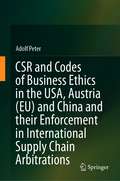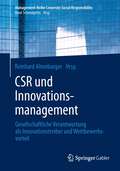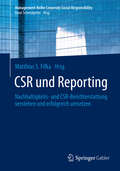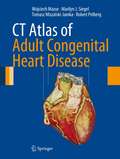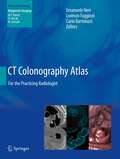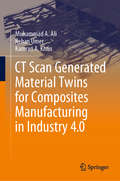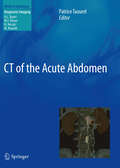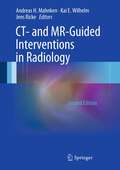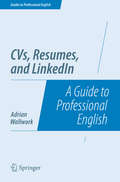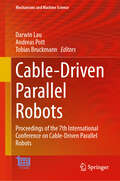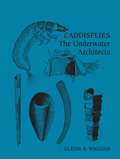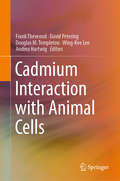- Table View
- List View
CSR Strategies: Corporate Social Responsibility for a Competitive Edge in Emerging Markets
by Sri UripGlobalization has changed the nature of many markets. Previously protected local industries have been forced to become more competitive, a situation that provides both opportunities and challenges. Key among these is the challenge of implementing responsible business practices. Corporate social responsibility (CSR) is widely recognized as a worthy commitment to ensure sustainable benefit for both corporations and communities. CSR is also becoming an important base for businesses to build trust and confidence in their stakeholders, with the potential to provide a competitive edge. To ensure sustainable growth opportunities, companies should pursue the three key dimensional values of creation: Profit People Planet Well defined and strategic CSR activities will ensure an optimum balance between social, environmental, and economic factors for sustainable profits. Hence, CSR has to be embedded within the business strategy to provide a competitive edge in the areas of brand equity, corporate reputation, employee retention, and environmental conservation. Although the principles of CSR are essentially the same globally, each location still calls for different emphasis in the implementation process. Successful application of CSR principles is directly influenced by the business understanding of its business strategy in proportion to the needs of the local community. As someone who has implemented all the above activities successfully, author Sri Urip is well placed to discuss effective CSR strategies to 21st century companies.
CSR and Codes of Business Ethics in the USA, Austria (EU) and China and their Enforcement in International Supply Chain Arbitrations
by Adolf PeterThis book analyzes the implementation of CSR reporting and codes of business conduct and ethics in the legal systems of the USA, Austria and China and their enforcement in international supply chain arbitrations. The book demonstrates that long-term profit maximization is increasingly intertwined with corporate ethics and CSR policies. In order to prevent window-dressing and greenwashing, certain control mechanisms and legal standards are required along the entire supply chain.This book introduces an ethics and CSR system recommending a reward-based whistleblowing mechanism, internal oversight by a CSR and Ethics Committee comprised of independent board members and at least one sustainability expert, and an external, independent and comprehensive assurance of CSR reports provided by auditing firms or newly formed governmental agencies consisting of certified CSR experts.The author emphasizes the significance for supply chain leaders to ensure contractual enforcement of their codes of business ethics and conduct along the supply chain. Against this background, the author created a comprehensive fictitious case scenario covering a supply chain dispute arising from the breach of the supply chain leader’s code of business conduct and ethics by a lower-tier supply chain member. The author acknowledges the fact that in most of the cases the governing law of international supply chain contracts is English law or law based on English law. Thus, the author discusses potential contractual claims for damages arising from a loss of profits caused by a loss of reputation resulting from violations of core provisions of the chain leader’s supplier code of conduct pursuant to English law. As international supply chain disputes usually involve more than two parties, and international arbitration is the ideal means for the resolution of these disputes, the book compares the arbitration rules for consolidations and joinders of some of the most significant international arbitration institutions: SIAC, ICC, AIAC, ICDR, VIAC, CIETAC and HKIAC.The book is directed at legal practitioners, legislators of various jurisdictions, board members of corporations, ethics and compliance officers, academics, researchers and students. It is the author’s main goal that the book serves as an inspirational source for the establishment or the improvement of a corporate ethics and CSR system preventing window-dressing and greenwashing and covering the entire supply chain. Furthermore, it is intended that students develop a deeper understanding for the enforcement of corporate ethics and CSR policies.
CSR und Brand Management: Marken nachhaltig führen (Management-Reihe Corporate Social Responsibility)
by Anne-Kathrin Kirchhof Oliver NickelMarken zählen zu den wichtigsten Werttreibern von Unternehmen. Zugleich sind sie relevante Bindeglieder und Vertrauensanker zwischen Unternehmen und Gesellschaft. Positioniert sich eine Marke gezielt als nachhaltig, kann ein Image- und Reputationsaufbau auf längere Sicht erfolgen. Marken werden auf diese Weise Ausdruck des CSR-Engagements eines Unternehmens und vermitteln Vertrauen, Transparenz und Partizipation. Die erfolgreiche Navigation von Marken auf wandelnden Märkten bleibt ein komplexes facettenreiches Thema. Ein nachhaltiges Brand Management ist, genauso wie CSR, ein elementarer Bestandteil der Unternehmensstrategie. Dieser Band zeigt, wie Marken systematisch und mit einem ganzheitlichen Ansatz erfolgreich geführt werden können.
CSR und Energiewirtschaft (Management-Reihe Corporate Social Responsibility)
by Alexandra Hildebrandt Werner LandhäußerWas bedeutet CSR in der Energiewirtschaft? Ein steigender Energiebedarf bei begrenzten natürlichen Ressourcen stellt Energieversorger, Industrie und Verbraucher vor immer neue Herausforderungen. Dieses Buch folgt einem interdisziplinären Ansatz und führt erstmals Debatten und Erkenntnisse aus Wirtschaft, Wissenschaft, Politik, Kultur und Medien zusammen. Denn die Energiewende kann nur gelingen, wenn sie für den Einzelnen fassbar wird und fragmentierte Sichtweisen und Interessenlagen zusammengeführt werden.
CSR und Energiewirtschaft (Management-Reihe Corporate Social Responsibility)
by Alexandra Hildebrandt Werner LandhäußerDieses Buch beleuchtet die Rolle von Corporate Social Responsibility (CSR) in der EnergiewirtschaftEin steigender Energiebedarf bei begrenzten natürlichen Ressourcen stellt Energieversorger, Industrie und Verbraucher vor neue Herausforderungen. Dieses Buch zeigt in einem interdisziplinären Ansatz, welche Bedeutung der Corporate Social Responsibility (CSR) in der Energiewirtschaft zukommt. Die Herausgeber führen erstmals Debatten und Erkenntnisse aus Wirtschaft, Wissenschaft, Politik, Kultur und Medien zusammen und betonen, dass die Energiewende nur gelingen kann, wenn sie für den Einzelnen fassbar ist und unterschiedliche Interessenlagen zusammenführt. Die zweite Auflage des Buches zeigt, dass es ein Trugschluss ist, zu meinen, dass der Klimaschutz beschlossen und geschafft sei. Es besteht noch immer akuter Handlungsbedarf. Erschienen in der Management-Reihe „Corporate Social Responsibility“ liegt der Schwerpunkt dieses Buchs auf dem Bereich der Energiewirtschaft. Ziel der Herausgeber ist es, Führungspersonen sowie Manager aus der Energiebranche dabei zu unterstützen, ihr Wissen und ihre Kompetenz im Themenfeld CSR zu erweitern. Die Beiträge maßgeblicher Expertinnen und Experten ergänzen mit diesem Werk bestehende Ansätze durch neue Ideen und Konzepte, um so für das Bewusstsein der Nachhaltigkeit einen neuen Standard in der Management-Literatur zu setzen. Steigen Sie tief in die CSR in der Energiewirtschaft ein Untergliedert in insgesamt zehn Teile, erfahren Sie in diesem Buch nicht nur mehr über Corporate Social Responsibility und die Grundlagen einer nachhaltigen Energiewirtschaft. Die Expertenbeiträge beleuchten außerdem diese Aspekte:Was verantwortungsbewusste Klimaschutz-Unternehmen auszeichnetEnergiemanagement: Das Bosch Engagement für eine nachhaltige Sicherung der EnergieversorgungEnergiewende in der Bau- und ImmobilienwirtschaftDas Blockchain-Prinzip: Pro und ContraDie Energie der Veränderung: Wandel in der ArbeitsweltDieses Buch über Corporate Social Responsibility in der Energiewirtschaft ist jedoch nicht nur eine Leseempfehlung für Unternehmer. Die Herausgeber möchten das komplexe Thema CSR praxisnah einer breiten Leserschaft – und damit auch den Energieverbrauchern – zugänglich machen. Auf diese Weise werden gesamtheitliche Zusammenhänge in der Wertschöpfungskette der Energieeffizienz mit Blick auf erneuerbare Energien nachvollziehbar abgebildet.
CSR und Innovationsmanagement: Gesellschaftliche Verantwortung als Innovationstreiber und Wettbewerbsvorteil (Management-Reihe Corporate Social Responsibility)
by Reinhard AltenburgerIn diesem Buch erfolgt eine fundierte Auseinandersetzung mit der Fragestellung wie die Corporate Social Responsibility (CSR)-Strategie bzw. -Ziele zu einer Verbesserung der Innovationsleistung von Unternehmen (Großunternehmen, KMU, Familienunternehmen) führen kann. Welche CSR-Aktivitäten sich dabei als besonders innovationsfördernd erweisen wird in dieser Publikation dargestellt. Dabei werden sowohl Produkt- als auch Dienstleistungs- und Geschäftsmodellinnovationen zur Erschließung neuer Märkte und der Steigerung der Wettbewerbsfähigkeit aufgezeigt. Weiters werden die damit in Verbindung stehenden organisatorischen und Managementinnovationen behandelt. Der erste Teil behandelt die Zugänge unterschiedlicher Wissenschaftler zu der Themenstellung und der zweite Teil umfasst zahlreiche Fallstudien von Unternehmen - Allianz, BASF, gugler, Henkel, ÖkoBusinessPlan Wien/VBV, Palfinger, SAP, Saubermacher, Volkswagen welche bereits konkrete CSR-getriebene inkrementelle und radikale Innovationen umgesetzt haben.
CSR und Reporting: Nachhaltigkeits- und CSR-Berichterstattung verstehen und erfolgreich umsetzen (Management-Reihe Corporate Social Responsibility)
by Matthias S. FifkaNachhaltigkeits- bzw. CSR-Reporting wird zunehmend zu einem Standard für Großunternehmen. 94% der 250 größten Unternehmen der Welt legen bereits einen Bericht zu den entsprechenden Aktivitäten vor. Dabei erfolgt zunehmend eine Orientierung an den Vorgaben der Global Reporting Initiative, die sich mehr und mehr als internationale Leitlinie durchsetzt. Obschon sich also eine gewisse Standardisierung hinsichtlich der Inhalte durchsetzt, gibt es noch immer große Unterschiede hinsichtlich der zur Verfügung gestellten Information. Dies gilt besonders im internationalen Vergleich. Dieses Buch gibt Ihnen einen Einblick in die bestehenden Unterschiede und zeigt wie CSR- und Nachhaltigkeitsberichterstattung erfolgreich implementiert werden kann. Dabei wird insbesondere auf die Chancen und Risiken zur Verfügung stehender Medien eingegangen.
CSR, Governance and Value (Approaches to Global Sustainability, Markets, and Governance)
by David Crowther Shahla SeifiThis book presents the changing face of social responsibility, showing how it has grown to encompass governance, becoming a vital part of various aspects of human endeavor. From businesses to politics to justice systems, Corporate Social Responsibility (CSR) has expanded its reach, touching every sphere of human activity. What is particularly interesting is how governance failures have highlighted its importance in addressing the economic and social challenges that many organizations face today. This shift has led to a reevaluation of the traditional triple bottom line approach, with governance and supplier behavior emerging as critical components of CSR. Stakeholders, especially consumers, are now actively monitoring companies, influencing their decisions and ultimately impacting their bottom line. The book critically examines these transformations in business behavior through the lenses of governance and CSR, questioning the need for redefining key concepts in the field. Authored by scholars from diverse global backgrounds, it blends theoretical insights with practical considerations, offering a comprehensive exploration of the evolving landscape. Drawing from the tradition of the Social Responsibility Research Network, known for its inclusive approach and emphasis on interdisciplinary research, the book presents varied perspectives and solutions derived from shared best practices. Based on contributions from the Network's recent conference, this book showcases both the unity and diversity of ideas within the field. By examining both theory and practice, it aims to deepen our understanding of these evolving trends and their implications for defining key concepts in social responsibility and governance.
CT Atlas of Adult Congenital Heart Disease
by Robert Pelberg Wojciech Mazur Marilyn J. Siegel Tomasz Miszalski-JamkaThe aims and scope of this atlas include a complete review of the embryology of the normal heart, the normal cardiac anatomy along with a complete discussion of the terms and definitions used to identify and clarify both normal and abnormal anatomy. In addition, techniques of cardiac CT angiography as it pertains to imaging congenital abnormalities are discussed including radiation concepts and radiation saving techniques. The bulk of this book then goes on to completely review the field of adult congenital heart disease using text and more importantly a multitude of pictorial examples (in color and grey scale) to demonstrate the abnormalities. Drawings accompany each picture to better explain the example. Furthermore, difficult and complex anatomical examples are supplemented with digital images and movies to aid in illustrating and understanding the anatomy. Each general set of anomalies as well as each specific abnormality or set of abnormalities includes a concise and simple review of the embryology and epidemiology of the abnormality as well as a concise explanation of the anatomy of the abnormality. In addition, the methods to identify and recognize the abnormality by computed tomography is discussed. Finally, the prognosis and common treatment options for the anomaly are addressed within this comprehensive book.
CT Colonography Atlas: For the Practicing Radiologist (Medical Radiology)
by Emanuele Neri Carlo Bartolozzi Lorenzo FaggioniThis easy-to-use atlas comprises a collection of representative common and unusual virtual colonoscopy (CT colonography, CTC) cases that physicians and radiologists may expect to encounter during their clinical practice. The atlas reflects the important recent advances in image acquisition, patient preparation, and image processing and is thus completely up-to-date. Each case is presented with the native CT images, integrated images obtained by 3D image processing, and colonoscopic correlation. Topics covered include normal appearances, anatomical variants, pitfalls, diverticula, lipomas, inflammatory bowel disease, polyps, flat lesions, cancers, and the postsurgical colon. By presenting the main features of anatomy and pathology, this atlas will serve as an invaluable tool both for radiologists performing CTC and for clinicians who need to review the CTC examinations of their patients.
CT Colonography for Radiographers: A Guide to Performance and Image Interpretation
by Joel H. Bortz Aarthi Ramlaul Leonie MunroThis second edition, comprising 28 chapters, explains every aspect of the role of radiographers in performing CT colonography (CTC) and interpreting CTC images with the aim of enabling radiographers to extend the scope of their practice. It provides information required with respect to communication with the patient, procurement of informed consent, the principles of CT as well as dual-energy CT and photon counting CT, radiation dose, patient preparation and positioning, the use of contrast media, the performance of diagnostic and screening CTC studies, the interpretation and reporting of images, legal and professional requirements, and the importance of clinical audits.A wide range of CTC findings is described and depicted, covering normal anatomy, artefacts, haemorrhoids, polyps, colon cancer, diverticular disease, lipomas, extracolonic structures, opportunistic screening for osteoporosis and metabolic associated fatty disease, and CTC in incomplete or failed colonoscopy. The role of other modalities such as ultrasound, magnetic resonance imaging, and nuclear medicine in colorectal cancer patients is discussed. In addition, the text covers the role of artificial intelligence and machine learning in imaging of the colon for the detection of polyps, diagnosis and staging of colorectal cancer. Lastly, a chapter focusing on self-assessment of image interpretation will aid learning.This book provides the support that radiographers need in order to perform CTC studies to the standard required in terms of advances in imaging and interpretation of images.
CT Scan Generated Material Twins for Composites Manufacturing in Industry 4.0
by Muhammad A. Ali Rehan Umer Kamran A. KhanThis book highlights a novel and robust platform in the form of in-situ characterization setup for creating X-ray computed tomography (XCT)-based textile material twins. In this hybrid experimental–numerical platform, XCT images of different complex fibrous reinforcements at different levels of compaction are acquired. The images are converted into computational models for resin flow simulations. The capabilities of this hybrid framework are applied to a variety of reinforcements used in liquid composite molding processes such as 2D, 3D fabrics and dry tapes. This book is a milestone in the development of virtual manufacturing protocols using material twins of textiles, providing a step closer to the digitalization of advanced composites used in manufacturing processes for industry 4.0.
CT of the Acute Abdomen (Medical Radiology)
by Patrice TaourelCT of the Acute Abdomen provides a comprehensive account of the use of CT in patients with acute abdomen. Recent important developments in CT, including multislice CT and multiplanar reconstructions, receive particular attention. CT features are clearly illustrated, and pitfalls and differential diagnoses are discussed. The first section of the book presents epidemiological and clinical data in acute abdomen. The second and third sections document the key CT findings and their significance and discuss the technological background. The fourth and fifth sections, which form the main body of the book, examine in detail the various clinical applications of CT in nontraumatic and traumatic acute abdomen. This book will serve as an ideal guide to the performance and interpretation of CT in the setting of the acute abdomen; it will be of value to all general and gastrointestinal radiologists, as well as emergency room physicians and gastrointestinal surgeons.
CT- and MR-Guided Interventions in Radiology
by Andreas H. Mahnken Jens Ricke Kai E. WilhelmInterventional radiology is an indispensable and still expanding area of modern medicine that encompasses numerous diagnostic and therapeutic procedures. The revised and extended second edition of this volume covers a broad range of non-vascular interventions guided by CT or MR imaging. Indications, materials, techniques, and results are all carefully discussed. A particularly comprehensive section is devoted to interventional oncology as the most rapidly growing branch of interventional radiology. In addition, detailed information is provided that will assist in establishing and developing an interventional service. This richly illustrated book will be a most valuable source of information and guidance for all radiologists who deal with non-vascular procedures.
CVs, Resumes, and LinkedIn: A Guide to Professional English (Guides to Professional English)
by Adrian WallworkAre you a graduate, postgraduate or PhD student? Are you simply looking for a new job in the private or public sector, in research or industry? If your aim is to produce a professional CV or resume, then this book is for you. Based on interviews with recruiters and HR managers, and an analysis of hundreds of CVs from around 40 different countries, the book is structured as a series of FAQs.Topics covered include:how recruiters and HR people analyse a CVwhether using a template is a good ideathe difference between a CV and a resumehow to present your personal details and whether to include a photohow to write an Executive Summarywhat to write in each section (Education, Work Experience, Skills, Personal Interests)how to write dateshow to highlight your language, communication and team skillshow to get and write referencesYou will also learn some hints and strategies for writing a:cover letterLinkedIn profilereference letterbioThe last chapter of the book contains a simple template to help you get the job of your dreams!
Caatinga: The Largest Tropical Dry Forest Region in South America
by José Maria Cardoso da Silva Inara R. Leal Marcelo TabarelliThis book provides in-depth information on Caatinga's geographical boundaries and ecological systems, including plants, insects, fishes, amphibians, reptiles, birds, and mammals. It also discusses the major threats to the region's socio-ecological systems and includes chapters on climate change and fast and large-scale land-use changes, as well as slow and small-scale changes, also known as chronic human disturbances. Subsequent chapters address sustainable agriculture, conservation systems, and sustainable development. Lastly, the book proposes 10 major actions that could enable the transformation of Caatinga into a place where people and nature can thrive together. "I consider this book an excellent example of how scientists worldwide can mobilize their efforts to propose sound solutions for one of the biggest challenges of modern times, i. e. , how to protect the world's natural ecosystems while improving human well-being. I am sure this book will inspire more research and conservation action in the region and perhaps encourage other groups of scientists to produce similar syntheses about their regions. " Russell Mittermeier, Ph. D. Executive Vice-Chair, Conservation International
Cabinet of Curiosities: Collecting and Understanding the Wonders of the Natural World
by Gordon GriceExactly the book for every young explorer who loves finding stuff in nature and bringing it home. Cabinet of Curiosities is a lavishly illustrated introduction to the wonders of natural history and the joys of being an amateur scientist and collector. Nature writer Gordon Grice, who started his first cabinet of curiosities at age six when he found a skunk’s skull, explains how scientists classify all living things through the Linnaeus system; how to tell real gold from fool’s gold; how to preserve butterflies, crab shells, feathers, a robin’s egg, spider specimens, and honeycombs; how to identify seashells; the difference between antlers and horns; how to read animal tracks. And then, what to do with your specimens, including how to build a cabinet of curiosities out of common household objects, like a desk organizer or a box for fishing tackle.
Cable Stayed Bridges: From Concept to Performance-based Design
by Ayman ShamaCable stayed bridges are seen as the alternative that fills the gap between long span bridges and suspension bridges. During the 1980s, several types of construction of cable stayed bridges such as steel, segmental concrete, composite steel and concrete superstructures emerged in different countries. The great evolution in computational methods, materials, and methods of construction has contributed to the tremendous development in state of the art cable stayed bridges in the past two decades. With spans that exceed one thousand meters, cable stayed bridges are now becoming a substitute for suspension bridges. This book outlines the development in the design of cable stayed bridges. Rigorous methods of analysis are presented. Simplified methods that lead to preliminary estimation of forces in major members for design are discussed. The book first reviews the evolution of this type of bridge, with focus on the vast development during the past twenty years. The book then discusses the basic principles of cable stayed bridges, related to aspects of analysis, design, construction, and maintenance. Specific issues such as aerodynamic stability of the bridges and different methods of testing and analysis required for this purpose are explained. Cable vibration problems are summarized and methods of its control are outlined. Special attention is given to the performance-based design method and one chapter is devoted towards explanation of the merits of this trend in design. Application of the method to the seismic and fire safety designs of cable stayed bridges is also covered.
Cable Supported Composite Bridges
by Changyu ShaoThis book introduces the latest developments in long-span cable-supported composite cable-stayed bridges, suspension bridges, and mid- and through-type cable-supported composite arch bridges. Based on the engineering application and practice of cable-supported composite bridges, this book systematically expounds the structural systems of these bridge types. It also summarizes the main construction methods, analyzes the mechanical properties of cable-stayed bridges and suspension bridges with composite girders and the influence rule with alternative spans, and proposes the reasonable span range based on economic efficiency. The prospect of using orthotropic composite bridge decks in long-span cable-supported bridges is also analyzed. This book is a valuable reference for both bridge professional technicians and graduate students for research, design and construction.
Cable-Driven Parallel Robots: Proceedings of the 7th International Conference on Cable-Driven Parallel Robots (Mechanisms and Machine Science #182)
by Andreas Pott Tobias Bruckmann Darwin LauThis volume gathers the latest advances, innovations and applications in the field of cable robots, as presented by leading international researchers and engineers at the 7th International Conference on Cable-Driven Parallel Robots (CableCon), held in Hong Kong on July 8-11, 2025. It covers the theory and applications of cable-driven parallel robots, including their classification, kinematics and singularity analysis, workspace, statics and dynamics, cable modeling and technologies, control and calibration, design methodologies, hardware development, experimental evaluation and prototypes, as well as application reports and new application concepts. The contributions, which were selected through a rigorous international peer-review process, share exciting ideas that will spur novel research directions and foster new multidisciplinary collaborations.
Cable-Driven Parallel Robots: Proceedings of the Second International Conference on Cable-Driven Parallel Robots (Mechanisms and Machine Science #32)
by Andreas Pott Tobias BruckmannThis volume presents the outcome of the second forum to cable-driven parallel robots, bringing the cable robot community together. It shows the new ideas of the active researchers developing cable-driven robots. The book presents the state of the art, including both summarizing contributions as well as latest research and future options. The book cover all topics which are essential for cable-driven robots: Classification Kinematics, Workspace and Singularity Analysis Statics and Dynamics Cable Modeling Control and Calibration Design Methodology Hardware Development Experimental Evaluation Prototypes, Application Reports and new Application concepts.
Cacao Diseases: A History of Old Enemies and New Encounters
by Bryan A. Bailey Lyndel W. MeinhardtThis book reviews the current state of knowledge concerning cacao pathogens and methods for their management. Topics discussed include the history, biology and genetic diversity of Moniliophthora (which causes witches' broom and frosty pod rot) and Phytophthora species (which causes black pod rot) that cause diseases resulting in major losses to cacao production. Emerging pathogens such as Cacao swollen shoot virus and Ceratobasidium theobromae (which causes vascular streak dieback) are also discussed in detail, along with many pathogens of significant local concern. Most of these pathogens represent major risks to global cacao production should they expand into new areas, breaking out of their current limited distributions. By considering cacao diseases as a group, similarities in the available tools and techniques used in their management become apparent, as do their limitations. Gaps in our current knowledge of cacao pathogens and the management of the diseases they cause are detailed, and suggestions for future research directions are provided. This insight allows readers to consider cacao disease threats from a more comprehensive, global perspective and paves the way for an improved synergy of efforts between the various research programs, agencies, and industries, both private and public, with vested interests in cacao production, and cacao farmers.
Cadaver Dissection with Clinical Applications
by Seth GardnerCadaver Dissection with Clinical Applications is written for students in a professional program that have been given the privilege of dissecting their own cadaver. It discusses dissection techniques, what structures to look for in a particular region and various pitfalls to avoid in the process. The Manual also relates regional anatomical structures with clinical relevance by listing various syndromes, relevant orthopaedic tests, selected X-ray findings and associated pathologies that relate to the region being dissected. It is a terrific resource for all students who will one day see patients in a clinical setting, by first learning anatomical relevance on a cadaver.
Caddisflies
by Glenn B. WigginsCaddisflies constitute the insect order Trichoptera in which some 10,000 species are known in the world, including about 1400 in North America. Fossil evidence shows that caddisflies originated in the Triassic period, 200-250 million years ago. They are important links in the movement of energy and nutrients through freshwater ecosystems due largely to the extraordinary diversification in their larval architecture, which includes portable and stationary shelters, silken filter nets, and osmotically semipermeable cocoons. Glenn Wiggins's Caddisflies is the foremost comprehensive reference source about these insects and is concerned with behavioural ecology, evolutionary history, biogeography, and biological diversity.Wiggins outlines fundamental concepts of aquatic ecology, illuminating the ways in which caddisflies help to make fresh waters work. Essential features of morphology, biology, and distribution are outlined for the twenty-six North American families of caddisflies and illustrated diagnostic keys are provided for larvae, pupae, and adults. The author also brings together information on caddisflies from widely scattered sources and provides comprehensive coverage of the scientific literature.
Cadmium Interaction with Animal Cells (Springerbriefs In Molecular Science)
by Andrea Hartwig Frank Thévenod David Petering Douglas M. Templeton Wing-Kee LeeThis book outlines the interaction of cadmium with the proteome and signalling molecules of mammalian cells. Chapters from expert contributors cover topics such as cadmium chemical biology, membrane receptors and transporters for cadmium and cadmium complexes, and targets of cadmium toxicity. Students and researchers working in bioinorganic chemistry will find this book an important account.

